Project Management Report: QAHE Uganda Field Trip Case Study Analysis
VerifiedAdded on 2023/01/13
|7
|1187
|44
Report
AI Summary
This report presents a project management analysis of a two-week field trip organized by QAHE's business faculty to Uganda, focusing on sustainable practices and addressing ethical and environmental concerns. The report details the project initiation document (PID), stakeholder analysis (students, faculties, investors, and government), budget allocation (£60,000 total, with £2,000 per student), work breakdown structure (WBS), and critical path analysis. The study aims to provide a comprehensive understanding of project management principles, including effective resource utilization, timeline adherence, and risk mitigation. The report concludes by emphasizing the importance of structured project planning for achieving desired outcomes within budget and time constraints, and reducing potential project risks.
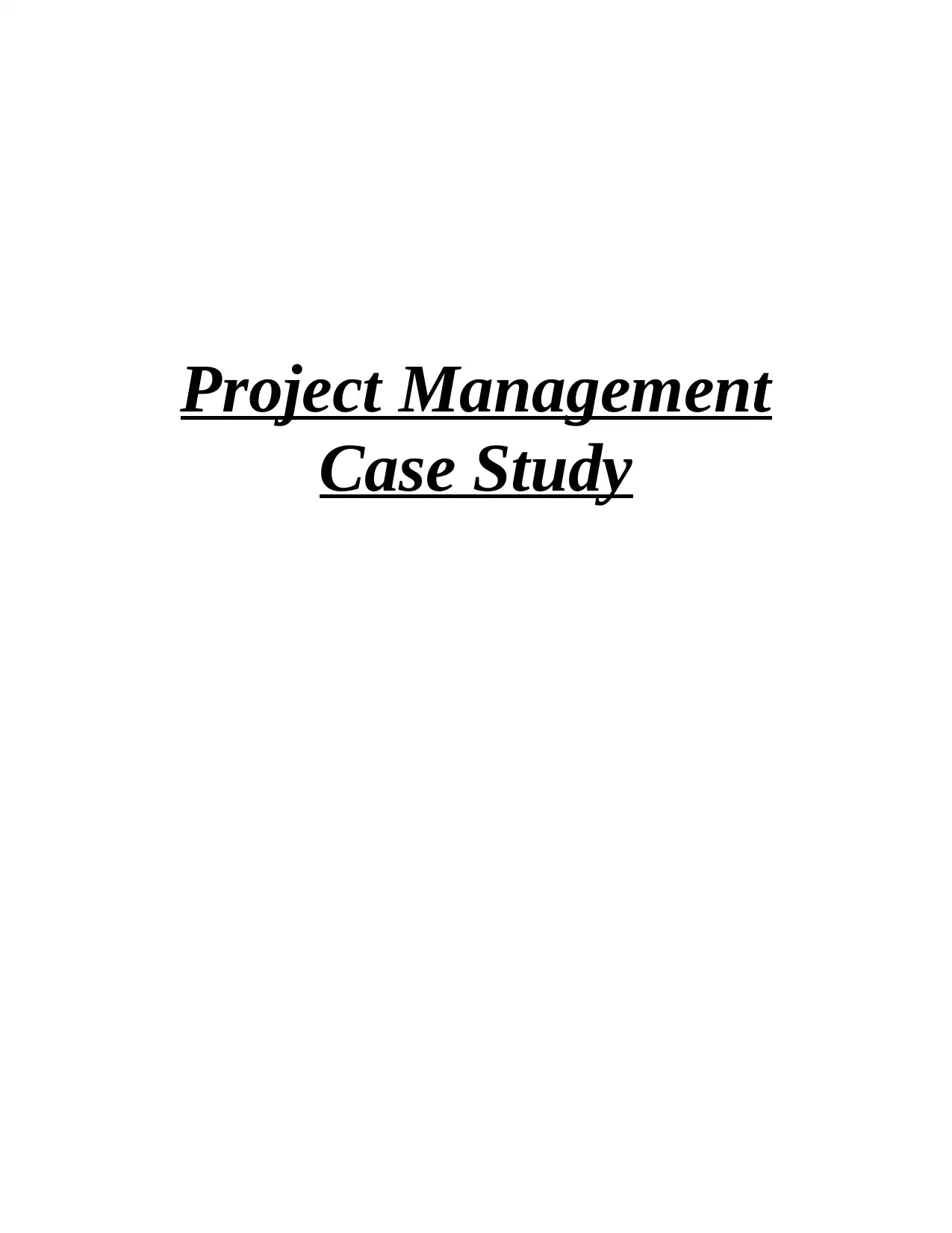
Project Management
Case Study
Case Study
Paraphrase This Document
Need a fresh take? Get an instant paraphrase of this document with our AI Paraphraser
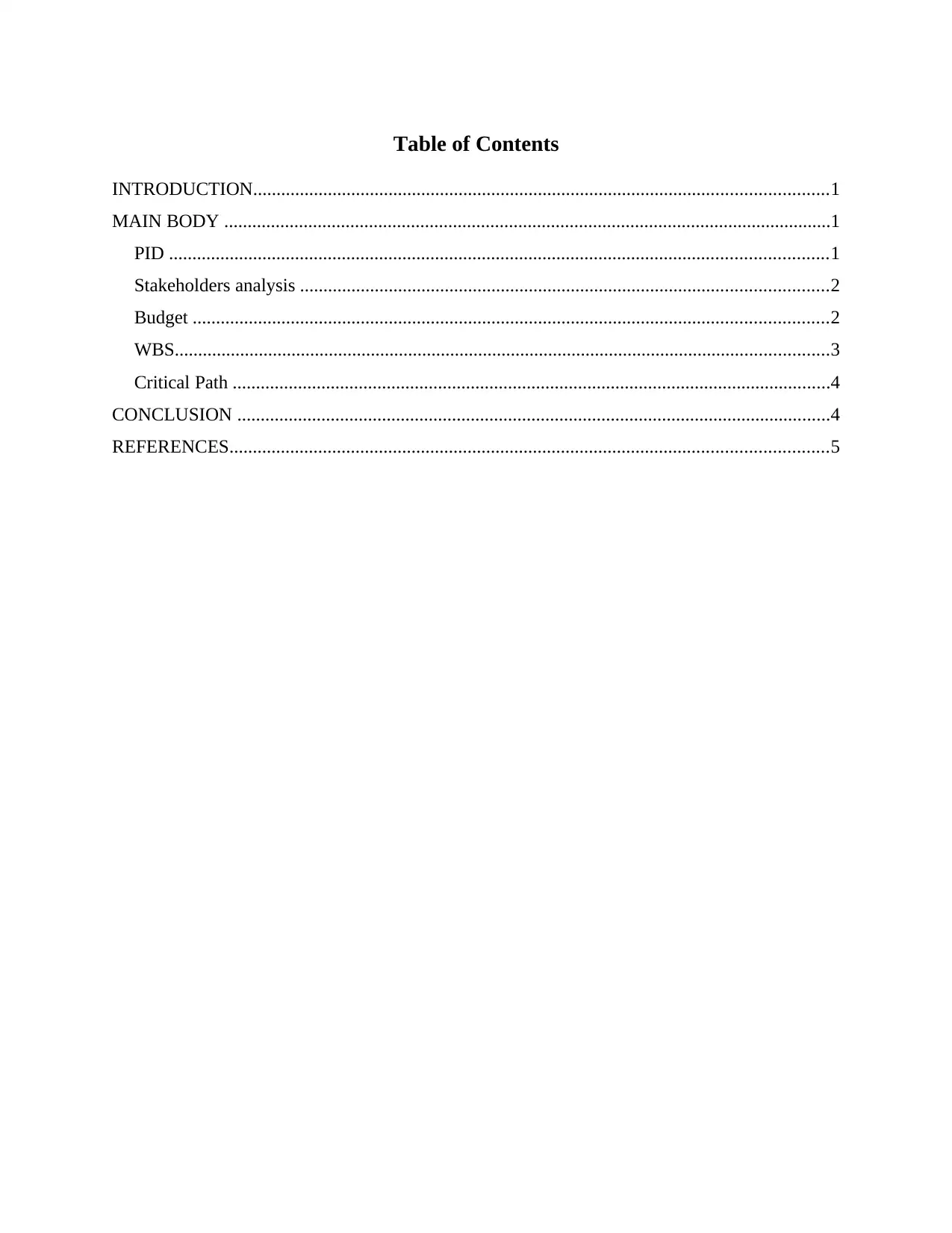
Table of Contents
INTRODUCTION...........................................................................................................................1
MAIN BODY ..................................................................................................................................1
PID .............................................................................................................................................1
Stakeholders analysis .................................................................................................................2
Budget ........................................................................................................................................2
WBS............................................................................................................................................3
Critical Path ................................................................................................................................4
CONCLUSION ...............................................................................................................................4
REFERENCES................................................................................................................................5
INTRODUCTION...........................................................................................................................1
MAIN BODY ..................................................................................................................................1
PID .............................................................................................................................................1
Stakeholders analysis .................................................................................................................2
Budget ........................................................................................................................................2
WBS............................................................................................................................................3
Critical Path ................................................................................................................................4
CONCLUSION ...............................................................................................................................4
REFERENCES................................................................................................................................5

INTRODUCTION
The term project management is comprises of different types of stages such as initiation,
planning, executing and controlling with an intent of achieving the pre defined objective in an
efficacious and efficient manner within stipulated time limit. Moreover, the application of project
management help organisation to identify the resources or requirements and also support them to
make use of available resources in order to maximise the profit in an amended mode (Delavari
and et.al., 2018). In regard of present study, it consider the case study of QAHE business faculty
who take an initiative to organise a two week field trip to Uganda. The main purpose behind this
trip is that to render detailed understanding about the course of sustainable practices and also to
control the ethical and environmental issues. Moreover, each students are funded of about £2,000
which help them to meet out the needs during travelling. However, this study includes PID,
Stakeholder analysis, budget, WBS, Gantt Chart and critical path for accomplishing the better
outcome in a desired time duration.
MAIN BODY
PID
The concept of PID (Project Initiation Document) is the combination of Prince2 which
encompasses the information regarding what will be delivered, when and how. Due to such
implication, it drive project manager to determine the marketplace competition or demand and
also assist them to implement best strategic decision for the enhancement of overall results in a
amended mode. In context of QAHE business faculty, application of PID enable them to
understand each students needs or demand and also aid them to organise each activity in a
systematic or effective manner without nay hindrances. The PID for QAHE's new course i.e.
sustainable practices are explained below:
Project Goal: To generate better understanding and knowledge about sustainable
practices in order to protect the atmosphere fro all types of ethical and environmental issues (Gist
and Guy, 2019).
Project size: Under this, QAHE analyse each individual capabilities or potentiality and
based delegate them role and responsibility which lead them to acquire reliable results in a
stipulated time duration.
1
The term project management is comprises of different types of stages such as initiation,
planning, executing and controlling with an intent of achieving the pre defined objective in an
efficacious and efficient manner within stipulated time limit. Moreover, the application of project
management help organisation to identify the resources or requirements and also support them to
make use of available resources in order to maximise the profit in an amended mode (Delavari
and et.al., 2018). In regard of present study, it consider the case study of QAHE business faculty
who take an initiative to organise a two week field trip to Uganda. The main purpose behind this
trip is that to render detailed understanding about the course of sustainable practices and also to
control the ethical and environmental issues. Moreover, each students are funded of about £2,000
which help them to meet out the needs during travelling. However, this study includes PID,
Stakeholder analysis, budget, WBS, Gantt Chart and critical path for accomplishing the better
outcome in a desired time duration.
MAIN BODY
PID
The concept of PID (Project Initiation Document) is the combination of Prince2 which
encompasses the information regarding what will be delivered, when and how. Due to such
implication, it drive project manager to determine the marketplace competition or demand and
also assist them to implement best strategic decision for the enhancement of overall results in a
amended mode. In context of QAHE business faculty, application of PID enable them to
understand each students needs or demand and also aid them to organise each activity in a
systematic or effective manner without nay hindrances. The PID for QAHE's new course i.e.
sustainable practices are explained below:
Project Goal: To generate better understanding and knowledge about sustainable
practices in order to protect the atmosphere fro all types of ethical and environmental issues (Gist
and Guy, 2019).
Project size: Under this, QAHE analyse each individual capabilities or potentiality and
based delegate them role and responsibility which lead them to acquire reliable results in a
stipulated time duration.
1
⊘ This is a preview!⊘
Do you want full access?
Subscribe today to unlock all pages.

Trusted by 1+ million students worldwide
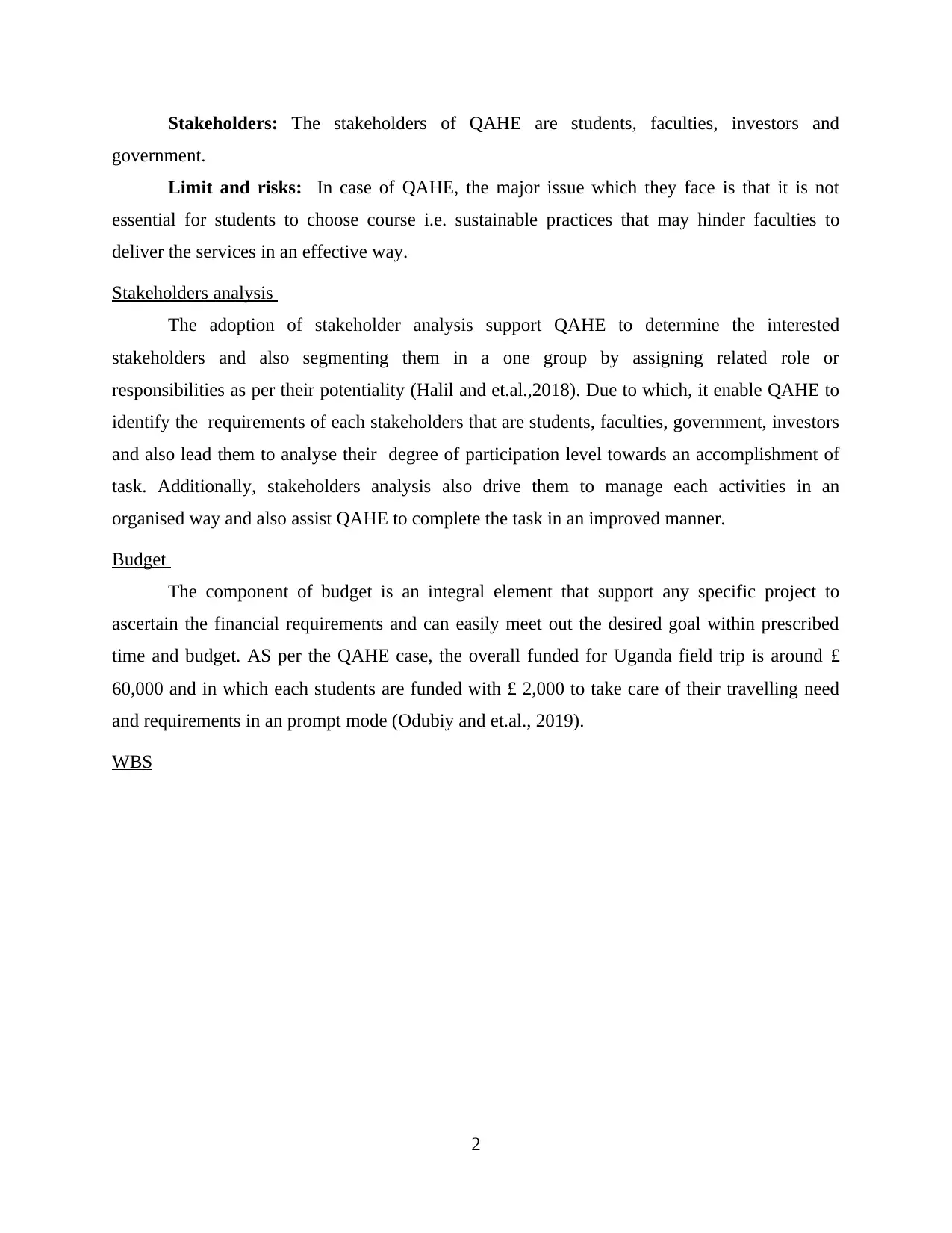
Stakeholders: The stakeholders of QAHE are students, faculties, investors and
government.
Limit and risks: In case of QAHE, the major issue which they face is that it is not
essential for students to choose course i.e. sustainable practices that may hinder faculties to
deliver the services in an effective way.
Stakeholders analysis
The adoption of stakeholder analysis support QAHE to determine the interested
stakeholders and also segmenting them in a one group by assigning related role or
responsibilities as per their potentiality (Halil and et.al.,2018). Due to which, it enable QAHE to
identify the requirements of each stakeholders that are students, faculties, government, investors
and also lead them to analyse their degree of participation level towards an accomplishment of
task. Additionally, stakeholders analysis also drive them to manage each activities in an
organised way and also assist QAHE to complete the task in an improved manner.
Budget
The component of budget is an integral element that support any specific project to
ascertain the financial requirements and can easily meet out the desired goal within prescribed
time and budget. AS per the QAHE case, the overall funded for Uganda field trip is around £
60,000 and in which each students are funded with £ 2,000 to take care of their travelling need
and requirements in an prompt mode (Odubiy and et.al., 2019).
WBS
2
government.
Limit and risks: In case of QAHE, the major issue which they face is that it is not
essential for students to choose course i.e. sustainable practices that may hinder faculties to
deliver the services in an effective way.
Stakeholders analysis
The adoption of stakeholder analysis support QAHE to determine the interested
stakeholders and also segmenting them in a one group by assigning related role or
responsibilities as per their potentiality (Halil and et.al.,2018). Due to which, it enable QAHE to
identify the requirements of each stakeholders that are students, faculties, government, investors
and also lead them to analyse their degree of participation level towards an accomplishment of
task. Additionally, stakeholders analysis also drive them to manage each activities in an
organised way and also assist QAHE to complete the task in an improved manner.
Budget
The component of budget is an integral element that support any specific project to
ascertain the financial requirements and can easily meet out the desired goal within prescribed
time and budget. AS per the QAHE case, the overall funded for Uganda field trip is around £
60,000 and in which each students are funded with £ 2,000 to take care of their travelling need
and requirements in an prompt mode (Odubiy and et.al., 2019).
WBS
2
Paraphrase This Document
Need a fresh take? Get an instant paraphrase of this document with our AI Paraphraser

3
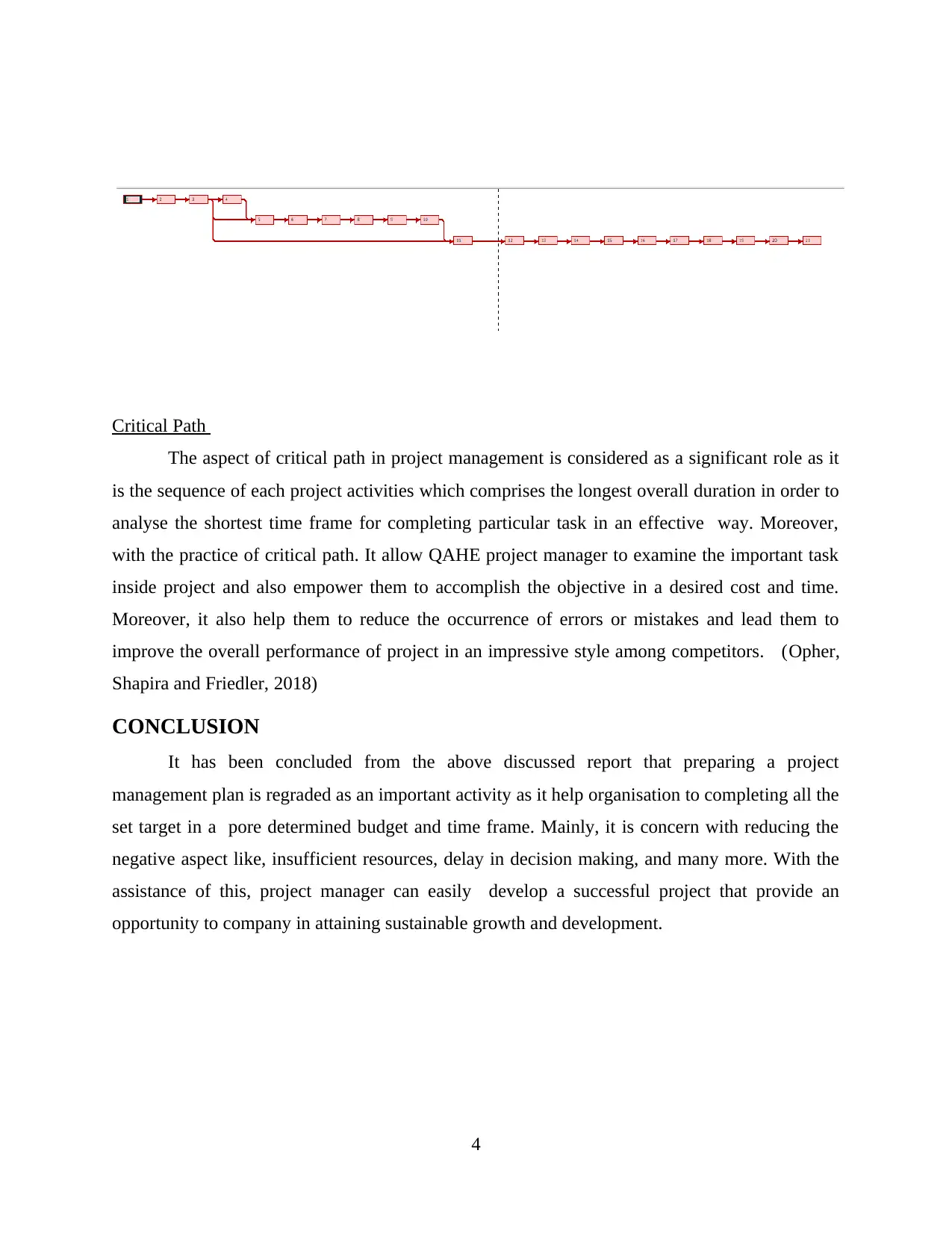
Critical Path
The aspect of critical path in project management is considered as a significant role as it
is the sequence of each project activities which comprises the longest overall duration in order to
analyse the shortest time frame for completing particular task in an effective way. Moreover,
with the practice of critical path. It allow QAHE project manager to examine the important task
inside project and also empower them to accomplish the objective in a desired cost and time.
Moreover, it also help them to reduce the occurrence of errors or mistakes and lead them to
improve the overall performance of project in an impressive style among competitors. (Opher,
Shapira and Friedler, 2018)
CONCLUSION
It has been concluded from the above discussed report that preparing a project
management plan is regraded as an important activity as it help organisation to completing all the
set target in a pore determined budget and time frame. Mainly, it is concern with reducing the
negative aspect like, insufficient resources, delay in decision making, and many more. With the
assistance of this, project manager can easily develop a successful project that provide an
opportunity to company in attaining sustainable growth and development.
4
The aspect of critical path in project management is considered as a significant role as it
is the sequence of each project activities which comprises the longest overall duration in order to
analyse the shortest time frame for completing particular task in an effective way. Moreover,
with the practice of critical path. It allow QAHE project manager to examine the important task
inside project and also empower them to accomplish the objective in a desired cost and time.
Moreover, it also help them to reduce the occurrence of errors or mistakes and lead them to
improve the overall performance of project in an impressive style among competitors. (Opher,
Shapira and Friedler, 2018)
CONCLUSION
It has been concluded from the above discussed report that preparing a project
management plan is regraded as an important activity as it help organisation to completing all the
set target in a pore determined budget and time frame. Mainly, it is concern with reducing the
negative aspect like, insufficient resources, delay in decision making, and many more. With the
assistance of this, project manager can easily develop a successful project that provide an
opportunity to company in attaining sustainable growth and development.
4
⊘ This is a preview!⊘
Do you want full access?
Subscribe today to unlock all pages.

Trusted by 1+ million students worldwide
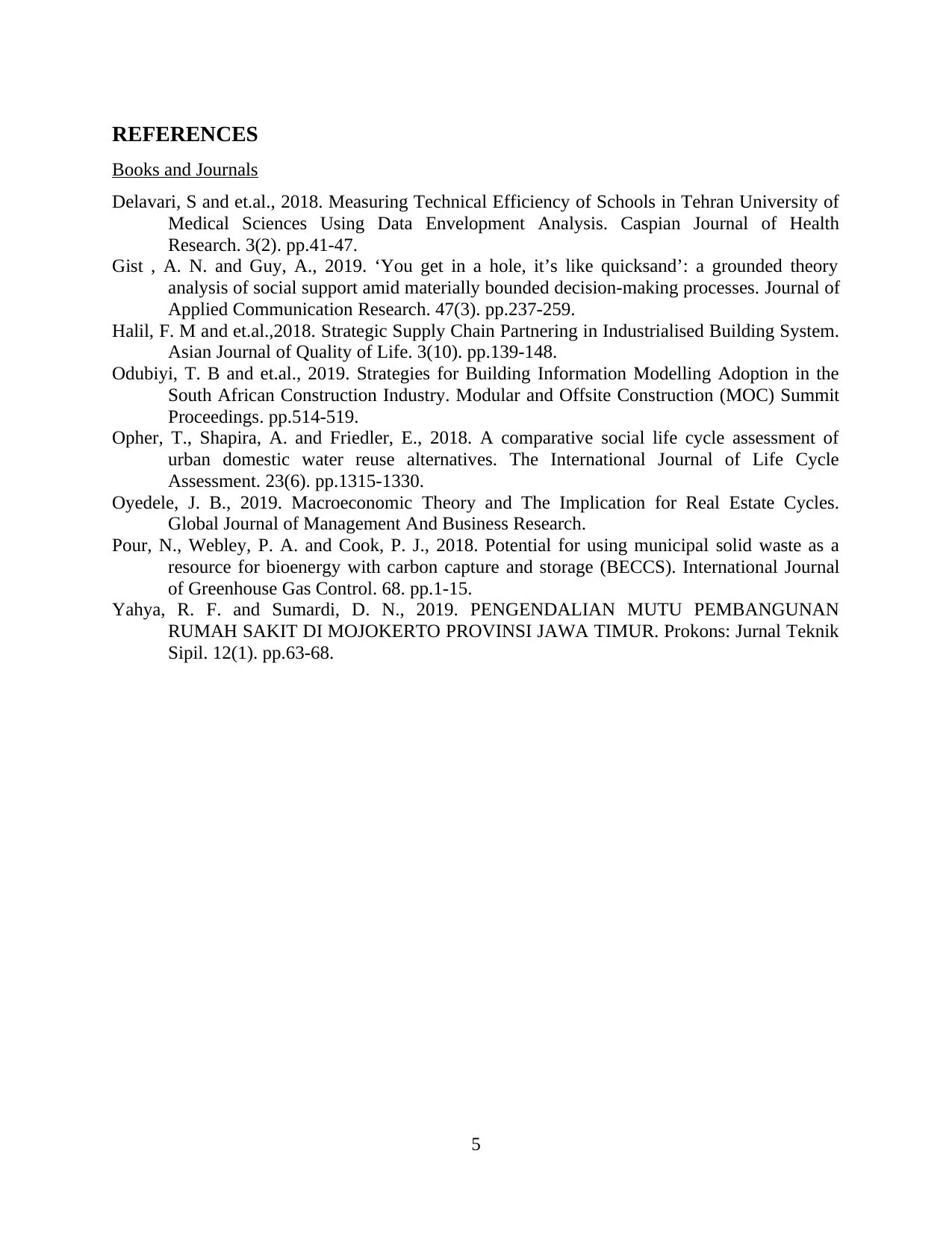
REFERENCES
Books and Journals
Delavari, S and et.al., 2018. Measuring Technical Efficiency of Schools in Tehran University of
Medical Sciences Using Data Envelopment Analysis. Caspian Journal of Health
Research. 3(2). pp.41-47.
Gist , A. N. and Guy, A., 2019. ‘You get in a hole, it’s like quicksand’: a grounded theory
analysis of social support amid materially bounded decision-making processes. Journal of
Applied Communication Research. 47(3). pp.237-259.
Halil, F. M and et.al.,2018. Strategic Supply Chain Partnering in Industrialised Building System.
Asian Journal of Quality of Life. 3(10). pp.139-148.
Odubiyi, T. B and et.al., 2019. Strategies for Building Information Modelling Adoption in the
South African Construction Industry. Modular and Offsite Construction (MOC) Summit
Proceedings. pp.514-519.
Opher, T., Shapira, A. and Friedler, E., 2018. A comparative social life cycle assessment of
urban domestic water reuse alternatives. The International Journal of Life Cycle
Assessment. 23(6). pp.1315-1330.
Oyedele, J. B., 2019. Macroeconomic Theory and The Implication for Real Estate Cycles.
Global Journal of Management And Business Research.
Pour, N., Webley, P. A. and Cook, P. J., 2018. Potential for using municipal solid waste as a
resource for bioenergy with carbon capture and storage (BECCS). International Journal
of Greenhouse Gas Control. 68. pp.1-15.
Yahya, R. F. and Sumardi, D. N., 2019. PENGENDALIAN MUTU PEMBANGUNAN
RUMAH SAKIT DI MOJOKERTO PROVINSI JAWA TIMUR. Prokons: Jurnal Teknik
Sipil. 12(1). pp.63-68.
5
Books and Journals
Delavari, S and et.al., 2018. Measuring Technical Efficiency of Schools in Tehran University of
Medical Sciences Using Data Envelopment Analysis. Caspian Journal of Health
Research. 3(2). pp.41-47.
Gist , A. N. and Guy, A., 2019. ‘You get in a hole, it’s like quicksand’: a grounded theory
analysis of social support amid materially bounded decision-making processes. Journal of
Applied Communication Research. 47(3). pp.237-259.
Halil, F. M and et.al.,2018. Strategic Supply Chain Partnering in Industrialised Building System.
Asian Journal of Quality of Life. 3(10). pp.139-148.
Odubiyi, T. B and et.al., 2019. Strategies for Building Information Modelling Adoption in the
South African Construction Industry. Modular and Offsite Construction (MOC) Summit
Proceedings. pp.514-519.
Opher, T., Shapira, A. and Friedler, E., 2018. A comparative social life cycle assessment of
urban domestic water reuse alternatives. The International Journal of Life Cycle
Assessment. 23(6). pp.1315-1330.
Oyedele, J. B., 2019. Macroeconomic Theory and The Implication for Real Estate Cycles.
Global Journal of Management And Business Research.
Pour, N., Webley, P. A. and Cook, P. J., 2018. Potential for using municipal solid waste as a
resource for bioenergy with carbon capture and storage (BECCS). International Journal
of Greenhouse Gas Control. 68. pp.1-15.
Yahya, R. F. and Sumardi, D. N., 2019. PENGENDALIAN MUTU PEMBANGUNAN
RUMAH SAKIT DI MOJOKERTO PROVINSI JAWA TIMUR. Prokons: Jurnal Teknik
Sipil. 12(1). pp.63-68.
5
1 out of 7
Related Documents
Your All-in-One AI-Powered Toolkit for Academic Success.
+13062052269
info@desklib.com
Available 24*7 on WhatsApp / Email
![[object Object]](/_next/static/media/star-bottom.7253800d.svg)
Unlock your academic potential
Copyright © 2020–2025 A2Z Services. All Rights Reserved. Developed and managed by ZUCOL.




